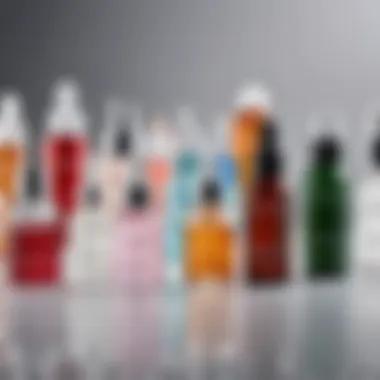Mastering Serum Application for Radiant Skin


Intro
Serums have become a central part of skincare routines for many individuals. Their high concentration of active ingredients indicates a tailored approach to address specific skin concerns. However, understanding how to optimally apply serums is often overlooked. This guide aims to clarify the essential aspects of serum application, showcasing how these products can enhance your skincare experience.
Ürün İncelemesi
Ürün Tanıtımı
When exploring serums, we can find options tailored for various skin types and concerns, such as hydration, anti-aging, or brightening. Serums contain smaller molecules than other skincare products, allowing them to penetrate deeper into the skin. Brands like The Ordinary and La Roche-Posay offer well-researched formulations designed to yield noticeable improvements when used correctly. When selecting a serum, it is critical to note the ingredients and their benefits. For example, vitamin C is known for its brightening effects, whereas hyaluronic acid excels in hydration.
Ürün Özellikleri
The unique characteristics of serums set them apart from creams or lotions. Some key features include:
- Concentration: Serums often contain a higher concentration of active ingredients compared to traditional moisturizers.
- Lightweight Texture: Their thinner consistency allows for quicker absorption.
- Versatility: Serums can be layered under moisturizers or sunscreen without feeling heavy on the skin.
Knowing these attributes can assist you when deciding which serum best fits your needs.
Güzellik İpuçları
Doğal Güzellik Yöntemleri
Incorporating natural beauty methods can complement the use of serums. For instance, using aloe vera gel as a natural alternative for hydration may enhance the effects of a hyaluronic acid serum. Similarly, green tea extract has antioxidant properties that can pair well with vitamin C serums.
Sağlıklı Beslenme ve Güzellik
Healthy eating directly impacts skin health. Including foods rich in vitamins, such as carrots (for vitamin A) and oranges (for vitamin C), supports the skin’s cellular function and overall appearance. This internal approach, combined with topical serum application, creates a comprehensive skincare regime.
"Investing in knowledge of serum application is as essential as the products you choose for your skincare."
By understanding the role of serums within your routine and their intended benefits, you can make informed decisions that elevate your skincare practices. This detailed insight aims to empower readers to achieve greater results and maintain healthy skin. Expanding one’s knowledge on serums paves the way for smarter skincare strategies.
The Role of Serums in Skincare
Skincare serums play a crucial role in modern skincare routines. Their formulations are often designed to address specific skin concerns with targeted active ingredients. Unlike standard moisturizers, serums contain a higher concentration of potent ingredients, allowing them to penetrate deeper into the skin. This depth of absorption is essential for achieving noticeable results. Because of their lightweight consistency, serums can easily layer underneath other products, making them versatile.
There are multiple benefits to incorporating serums into your skincare regimen. First and foremost, they can enhance hydration, improve skin texture, and combat issues like aging, acne, and hyperpigmentation. Their formulation often includes a variety of key ingredients that are known for their efficacy.
Choosing the right serum is not only about personal preference but also about understanding the skin's specific needs. One must consider factors such as skin type, environmental influences, and individual concerns when selecting the appropriate product. This makes knowledge about skincare serums essential for those who aim to optimize their skin health.
"Choosing the right serum can significantly impact your skincare results and routine."
In summary, understanding the role of serums in skincare is fundamental. They serve as specialized treatments that complement everyday products. Their strategic use can lead to improved skin health and appearance, making the study of their application both relevant and necessary.
Defining Skincare Serums
Skincare serums are highly concentrated formulas that are designed for delivering specific nutrients to the skin. Unlike other skincare products, serums are light in texture, allowing them to penetrate deeper layers of the skin more effectively. Many serums boast active ingredients, such as vitamins, antioxidants, or peptides, each serving a unique purpose. Typically, serums have a thinner consistency compared to creams and lotions, which makes them an excellent first step in a layered skincare approach.
Key Ingredients to Look For
When selecting a serum, it is vital to consider the active ingredients included. The effectiveness of a serum often depends on its formulation, which can vary widely.
Vitamins and Antioxidants


Vitamins and antioxidants are essential components in many serums. They help combat oxidative stress caused by environmental factors, such as pollution and UV radiation. Vitamin C, for example, is an effective antioxidant that brightens the skin and minimizes signs of aging. Those seeking to enhance their skincare should prioritize products rich in vitamins, as they offer substantial benefits for overall skin health. The unique feature of antioxidants lies in their ability to neutralize free radicals, which can lead to premature aging.
Peptides and Growth Factors
Peptides and growth factors are increasingly popular in skincare due to their ability to stimulate skin repair and regeneration. Peptides are short chains of amino acids that promote collagen production, resulting in firmer skin. This characteristic makes them a beneficial choice for those looking to reduce fine lines. Growth factors also encourage cellular turnover, contributing to overall skin vitality. However, it is important to note that the effectiveness of these ingredients can vary, depending on their concentration and formulation.
Hyaluronic Acid and Moisturization
Hyaluronic acid is well-known for its ability to attract and retain moisture in the skin. As a naturally occurring substance, it holds up to 1,000 times its weight in water, making it highly effective for hydration. It is often included in serums aimed at plumping the skin and reducing the appearance of fine lines. Its unique feature is the ability to provide immediate hydration, which is particularly advantageous for those with dry or dehydrated skin. However, overuse may lead to temporary moisture loss in some cases, so it is essential to use it thoughtfully.
Incorporating these key ingredients into a skincare routine can dramatically improve skin health and appearance. Thus, selecting serums with these components can enhance the overall effectiveness of your skincare efforts.
Choosing the Right Serum
Selecting the appropriate serum is central to enhancing a skincare routine. The right serum can address specific skin concerns effectively and can significantly improve the overall health of the skin. This section will provide insight into determining the appropriate serum by examining skin types and common skin concerns.
Understanding Skin Types
Normal Skin
Normal skin is often considered the ideal skin type due to its balanced characteristics. It is neither too oily nor too dry and typically has few visible pores. People with normal skin can enjoy a variety of serums without necessarily worrying about clogging the pores or causing breakouts. A serum designed for normal skin can emphasize hydration and protection, leading to a visually pleasing and healthy appearance. Consequently, individuals with normal skin often benefit from serums rich in antioxidants, providing skin with necessary defenses against environmental stressors.
Oily Skin
Oily skin is marked by excess sebum production, often resulting in a shiny appearance. People with this skin type can struggle with acne and large pores. This specific condition leads to a demand for serums that help balance oil production. Lightweight formulations that contain salicylic acid or tea tree oil can be beneficial in preventing breakouts. Choosing an oil-free serum can significantly aid in controlling shine and boosting hydration without further clogging the pores.
Dry Skin
Dry skin can feel tight and uncomfortable, often associated with flaking and rough patches. Individuals with dry skin must seek serums containing powerful moisturizing agents. Ingredients such as hyaluronic acid and glycerin can provide deep hydration and help retain moisture levels in the skin. When tailored for dry skin, serums can enhance the skin's barrier function, offering protection against external environmental factors.
Combination Skin
Combination skin presents unique challenges. It typically features oily areas, usually around the T-zone, along with dry or normal areas elsewhere. This variation can make it challenging to choose a serum. Individuals with combination skin should consider serums that cater to both the oily and dry areas or those designed to balance the skin overall. The ideal serum would contain lightweight moisturizers and some balanced exfoliants to handle the differing needs of the skin surface.
Identifying Skin Concerns
Acne
Acne is a prevalent skin condition, characterized by pimples, blackheads, and cysts. Addressing acne effectively requires a serum formulated with specific ingredients like salicylic acid and niacinamide. These components work to reduce inflammation and prevent future breakouts. For those struggling with acne, finding a serum tailored towards controlling oil and targeting blemishes can greatly aid in achieving clear skin.
Hyperpigmentation
Hyperpigmentation, the darkening of certain areas of the skin, can result from sun exposure or hormonal changes. This issue can detract from a smooth complexion. Serums rich in vitamin C are effective for brightening and evening skin tone. Using a serum that targets hyperpigmentation can assist in fading stubborn spots and promote a more uniform appearance.
Fine Lines and Wrinkles
Fine lines and wrinkles are signs of aging that concern many individuals. Solutions often lie in serums containing peptides and retinol, promoting cellular turnover and collagen production. These ingredients help smooth out skin texture and minimize the appearance of aging signs. A targeted serum can contribute significantly to maintaining a youthful appearance.
Dehydration
Dehydrated skin may appear dull and feel tight. It is essential to differentiate between dryness and dehydration—while the former relates to a lack of oil, dehydration indicates insufficient water levels. For dehydrated skin, serums packed with hyaluronic acid can offer vital moisture. Hydrating serums are crucial for enhancing the skin's ability to hold water, which is necessary for maintaining a healthy complexion.
Selecting the right serum according to skin type and concerns is imperative. The right product can yield significant improvements in overall skin health.
Best Practices for Serum Application


Using a serum correctly can greatly enhance its effectiveness for the skin. Best practices involve a combination of preparation, application techniques, and understanding the skin's needs. This section delves into the essential steps that maximize the benefits of serums. Proper application techniques ensure that the products penetrate optimally and are more efficacious.
Preparation of the Skin
Cleaning and Exfoliating
Cleaning and exfoliating the skin lay the groundwork for any skincare routine. Removing dirt, oil, and dead skin allows the serum to penetrate better and work more effectively. Key characteristics of cleaning and exfoliating include helping to unclog pores and preventing breakouts.
Exfoliating also sloughs off dead skin cells, revealing fresh skin underneath. This no doubt contributes to a more luminous complexion. It is a popular choice in this article because it enhances serum absorption significantly. However, over-exfoliation can lead to irritation or damage. It is advantageous to choose gentle exfoliating methods, such as physical exfoliants or chemical exfoliants like alpha-hydroxy acids, which are less abrasive on the skin.
Toning and Hydrating
Toning and hydrating the skin creates an optimal environment for serums to function. Toners balance the skin’s pH levels and can remove any leftover impurities missed during cleansing. The key characteristic of toning is enhancing hydration, which prepares the skin for better serum absorption.
Hydrating toners can provide a refreshing layer of moisture that assists in serum effectiveness. This step is beneficial as it preps the skin, making it more receptive to subsequent products. Not all toners are created equal, though; alcohol-based toners can be drying, leading to more significant concerns. Therefore, the unique feature of hydrating toners is their potential to nourish the skin without stripping it of essential oils.
Application Techniques
Dropping and Spreading
Dropping and spreading serums is a common method that ensures even distribution across the face. The key characteristic of this technique involves applying a few drops of serum directly to the skin and gently spreading it with fingertips. It is a beneficial method in this article as it helps to save product and encourages uniform application.
When using this technique, ensure that the serum is spread evenly. Overwhelming a specific area can lead to buildup. The advantage of this method is that it allows for direct control over how much product is used, preventing wastage.
Patting and Pressing
Patting and pressing involve dabbing the serum onto the skin instead of spreading it. This method allows the skin to absorb the serum effectively. Patting promotes deeper penetration of active ingredients and activates blood circulation.
This technique is considered popular in this article because it feels soothing and provides an additional element of care to the skin. The unique feature of this technique is its ability to engage the skin without being harsh, which is essential for sensitive skin. Furthermore, it encourages even absorption, preventing any patches from looking overladen.
Layering with Other Products
Layering serums with other skincare products maximizes their effectiveness. This is notably important for those with multifaceted skin concerns. A key characteristic of this practice is that it enables users to customize their regimen according to their needs.
Layering involves ensuring that each product, including serums, gets a chance to absorb before proceeding to the next. This article champions layering as it allows individuals to address various concerns like hydration, anti-aging, or brightening simultaneously. However, layering too many products can lead to minimal absorption. Managing the order, applying lighter products first and moving to heavier ones, is crucial.
"Effective serum application is not just about the product but how you prepare and apply it to your skin."
Understanding and implementing these best practices ensures you get the most benefit from your serums. Each step lays a foundation for a more effective skincare routine.
Timing for Maximum Effectiveness
Understanding when to apply your serum can greatly influence its effectiveness. Timing ensures that your skin absorbs the product at optimal times, leading to better results. Serums often contain active ingredients designed to target specific skin concerns, and no matter how potent these ingredients are, their benefits can be diminished without proper application timing.
Morning vs. Evening Application
Serums can be applied either in the morning or evening, and each time has its specific purpose. Morning application is beneficial when you need protection against environmental stressors. Applying a vitamin C serum in the morning can provide antioxidants that defend against free radicals from sun exposure and pollution.
On the other hand, evening application allows for deeper penetration and renewal. At night, your skin repairs itself, making it an ideal time for serums containing retinoids or peptides. These ingredients can promote cell turnover and improve skin texture. Overall, consider using lightweight serums in the morning and more intensive treatments at night to maximize benefits.
Layering with Other Skincare Products
Layering is crucial when applying serums. Using serums effectively alongside moisturizers or sunscreens can lead to enhanced skincare routines. The order of application is essential to ensure that each product works well without compromising the effects of others.
Serum and Moisturizer


Using serum before moisturizer creates a powerful hydration combo. Serums are often lighter and meant to penetrate deeper into the skin. Once absorbed, a moisturizer seals in those benefits, ensuring hydration remains locked in. A key characteristic of this combination is that serums are concentrated, which allows for targeted treatment. The unique feature of a moisturizer is its ability to create a barrier against environmental factors.
Choosing serums with ingredients like hyaluronic acid paired with rich moisturizers can provide optimal hydration. However, overusing products can sometimes lead to feeling greasy or clogged pores if the sizes or weights of layers does not match the skin type.
Serum and Sunscreen
Using serum in conjunction with sunscreen is essential for protection against UV rays. Sunscreen acts as a shield and should always be the last step in the morning skincare routine. A beneficial aspect of using serum and sunscreen together is the added layer of protection against aging, as many serums contain antioxidants that can improve sunscreen effectiveness.
The distinct feature of this paired application is that both products can enhance skin defense. However, improper application, such as applying sunscreen first, can diminish the protective effects of the serum. It’s crucial to allow serums to absorb fully before applying sunscreen for best results and maximizing skin health.
Common Mistakes in Serum Application
When it comes to skincare serums, understanding how to apply them correctly is crucial. However, many individuals fall into particular traps that can hinder the effectiveness of their serums. Recognizing these common mistakes is vital for achieving the desired results from serums and ensuring overall skin health.
Overusing Products
One of the frequent mistakes people make is applying too much serum. Many think that using a larger quantity will enhance the benefits, but this is not true. The skin can only absorb a certain amount of product at a time. Overapplying can lead to skin congestion and irritation. It is essential to follow the recommended usage, which is usually a few drops. More product does not equate to better results.
Neglecting Skin Sensitivity
Ignoring skin sensitivity when selecting and applying serums leads to poor outcomes. Every person's skin has different reactions to various ingredients. For example, an individual may find that a serum with retinol irritates their skin, while another person sees no issues. It is crucial to perform a patch test before fully integrating a new serum into your routine. If irritation occurs, it’s wise to discontinue use or consult a dermatologist. Understanding your skin’s specific response can greatly influence the effectiveness of the product.
Improper Storage of Serums
The way you store serums can also affect their longevity and efficacy. Many serums contain active ingredients that can degrade when exposed to light, heat, or air. Storing them in a cool, dark place is important. For example, keeping serums in the bathroom can expose them to moisture and heat from showers. Instead, a drawer or a shelf away from sunlight is better. Using serums past their expiration date can also compromise results.
Key Point: Proper use, understanding skin reactions, and correct storage are fundamental in maximizing the benefits of skincare serums.
In summary, avoiding these common mistakes is essential for getting the most out of skincare serums. By minding usage amounts, being aware of skin sensitivity, and ensuring appropriate storage, individuals can optimize their skincare routine and achieve better, healthier skin results.
Monitoring Results and Adjusting Routines
Monitoring results and adjusting routines is a critical component in skincare, especially when using serums. This practice allows individuals to assess how their skin responds to various products over time. Skin is dynamic, and its needs can change due to several factors, such as climate, diet, stress, and hormonal changes. By observing how serums affect the skin, one can make informed choices to enhance their skincare regimen.
Skin's Response to Serums
Observing Changes
Observing changes is essential to understanding how a serum interacts with one’s skin. This aspect focuses on being attentive to alterations in skin texture, tone, and overall appearance. A beneficial characteristic of observing changes is its ability to provide immediate feedback. For example, if a serum claims to boost hydration, noticing improved moisture levels can validate its effectiveness.
The unique feature of observing changes lies in the intuitive understanding it fosters. Individuals can learn which ingredients work best for their specific needs. However, some may find it challenging, as changes might not be apparent right away. Importantly, patience is necessary; visible results often take days or even weeks.
Adjusting Frequency of Use
Adjusting frequency of use is paramount in optimizing the serum's benefits. This involves evaluating how often to apply a particular serum based on skin reaction. A key characteristic of this approach is flexibility. Depending on skin sensitivity, some may benefit from daily applications, while others might require spacing out use to avoid irritation.
The unique aspect of adjusting frequency is its customization. Skincare is not one-size-fits-all; tailoring the routine to one’s skin requirements can lead to better outcomes. However, too frequent use can overwhelm the skin, leading to redness or breakouts. Therefore, careful observation and gradual alterations are necessary to avoid adverse effects.
When to Change Your Serum
After Skin Changes
Changing your serum after skin changes is vital for ensuring continued effectiveness. Skincare is not static, and the skin can react to internal or external factors over time. A significant characteristic of this approach is adaptability. If skin becomes dry or more oily, it signals a need for different ingredients that address these shifts.
The unique feature of changing serums after skin changes is its proactive nature. Addressing skin concerns before they exacerbate can lead to healthier skin overall. A potential disadvantage is that some may feel discouraged when faced with the need to frequently adjust their routines. Nevertheless, it is crucial to recognize that skincare is an evolving process.
Evaluating Product Effectiveness
Evaluating product effectiveness is essential in maintaining an effective skincare routine. This involves scrutinizing how well a serum delivers on its promises. A key characteristic of evaluating effectiveness is objectivity. By keeping a journal or taking photographs, individuals can track changes over time, making it easier to assess results.
The unique feature of evaluating product effectiveness is the empowerment it brings. A person can feel confident in their choices and switch products when results fall short. However, it does require diligence and honesty in evaluating one's skin. This process may reveal that a previously loved product no longer suits individual needs, prompting the need for change.







